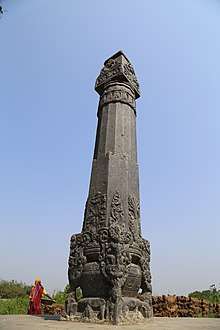Karnat dynasty
The Karnat or Karnata Dynasty originated with establishment of a kingdom in 1097 CE headquartered at present day Simraungadh in Bara District. The kingdom controlled the areas we today know as Tirhut or Mithila in India and Nepal. This region is bounded by the Mahananda River in the east, the Ganges in the south, the Gandaki River in the west and by the Himalayas in the north.[1][2] The boundary line was made between the two countries after the Treaty of Sugauli in 1816.
According to French orientalist and indologist Sylvain Lévi, Nanyadeva established his supremacy over Simraungadh probably with the help of Chalukya king Vikramaditya VI.[3][4][5] After the reign of Vikramaditya VI in 1076 CE, he led the successful military campaign against the Sena dynasty.[6][7]

Invasion
Harisingh Dev (r. 1295 to 1324 CE), the sixth descendant of Nanyadeva was ruling the Tirhut Kingdom. At the same time the Tughlaq dynasty comes to power, which ruled the Delhi sultanate and whole Northern India from 1320 to 1413 CE. In 1324 CE, the founder of the Tughlaq dynasty and Delhi Sultan, Ghiyasuddin Tughlaq turned his attention towards Bengal.[8] The Tughlaq army invaded Bengal and on his way back to Delhi, The sultan heard about the Simraungarh which was flourishing inside the jungle.[9] The last king of the Karnata dynasty Harisingh Dev didn't show his strength and left the fort as he heard the news of approaching army of the Tughlaq Sultan towards the Simraungarh.[10] The Sultan and his troop stayed there for 3 days and cleared the dense forest. Finally on day 3, the army attacked and entered into the huge fort whose walls was tall and surrounded by 7 big ditches.[11]
The remains are still scattered all over the Simroungarh region. The king Harisingh Deva fled northwards into the then Nepal. The son of Harisingh Dev, Jagatsingh Dev married the widow princess of Bhaktapur Nayak Devi.[12]
Rulers
The rulers of Simraongarh are as follows:
| S.N. | Name of the rulers | Timeline | Notes |
|---|---|---|---|
| 1 | Nanyadeva.[13] | 1097 - 1147 CE[14] | |
| 2 | Ganga Dev[13] | 1147 - 1187 CE[14] | |
| 3 | Narsingh Dev[13] | 1187 - 1227 CE[14] | |
| 4 | Ramsingh Dev[13] | 1227 - 1285 CE[14] | |
| 5 | Shaktisingh Dev[13] | 1285 - 1295 CE[14] | |
| 6 | Harisimhadeva[13] | 1295 - 1324 CE[14] |
Descendants
It is said that after his defeat, Harisimhadeva fled to Kathmandu where his descendants became the founders of the Malla dynasty of Kathmandu. The Mallas were noted as great patrons of the Maithili language.[15]
It is also said that another branch of the Karnats remained in Mithila and their descendants became the Gandhavariya Rajputs of North Bihar who held many chiefdoms in the region.[16][17]
See also
References
- Jha, M. (1997). "Hindu Kingdoms at contextual level". Anthropology of Ancient Hindu Kingdoms: A Study in Civilizational Perspective. New Delhi: M.D. Publications Pvt. Ltd. pp. 27–42.
- Mishra, V. (1979). Cultural Heritage of Mithila. Allahabad: Mithila Prakasana. p. 13.
- Magazine, New Spolight. "Sylvain Lévi's Le Népal". SpotlightNepal. Retrieved 2019-04-15.
- Majumdar, Ramesh Chandra (1957). The Struggle For Empire. Bharatiya Vidya Bhavan, 1957. p. 47.
- Levi, Sylvain (2015-02-18). Le Népal: Étude Historique D'Un Royaume Hindou - Scholar's Choice Edition. Creative Media Partners, LLC. ISBN 9781297173240.
- Somers, George E. (1977). Dynastic History Of Magadha. Abhinav Publications. ISBN 9788170170594.
- Mukherjee, Ramkrishna; Mukherjee, Roopali (1974). Rise and Fall East India. NYU Press. ISBN 9780853453154.
- Choudhary, Radhakrishna (1970). History of Muslim rule in Tirhut, 1206-1765, A.D. Chowkhamba Sanskrit Series Office.
- Thapa, Netra Bahadur (1981). A Short History of Nepal (PDF). Ratna Pustak Bhandar. pp. 38–39.
- Abdusi Akhsatan Dehlavi, Mohammad bin Sadr Taj (1301–1335). "Basatin-Ul Uns". Center for Persian Research: XXI. Cite journal requires
|journal=(help)CS1 maint: date format (link) - Abdul Malik Isami (1981). "Futuh-us-Salatin". University of Madras: 38–39. Cite journal requires
|journal=(help) - "Simroungarh | Nepal | Heritage & Archaeological Site".
- Hodgson, B. H. (1835). "Account of a Visit to the Ruins of Simroun, once the capital of the Mithila province". Journal of the Asiatic Society. 4: 121−124.
- Chaudhary, Radhakrishna. Mithilak Itihas [मिथिलाक इतिहास] (in Hindi). Ram Vilas Sahu. pp. 70–112. ISBN 9789380538280.
- Brinkhaus, Horst (1991). "The Descent of the Nepalese Malla Dynasty as Reflected by Local Chroniclers". Journal of the American Oriental Society. 111 (1): 118–122. doi:10.2307/603754. JSTOR 603754.
- P. Pathak (1983). "Origin of the Gandhavaria Rajputs of Mithila". The Journal of the Bihar Puravid Parisad. Vii And Viii: 406–420.
- Bindeshwari Prasad Sinha (1974). Comprehensive History Of Bihar Vol.1; Pt.2. Retrieved 8 January 2019.